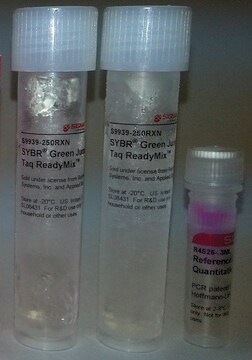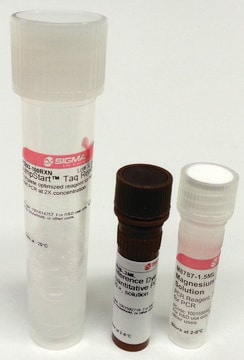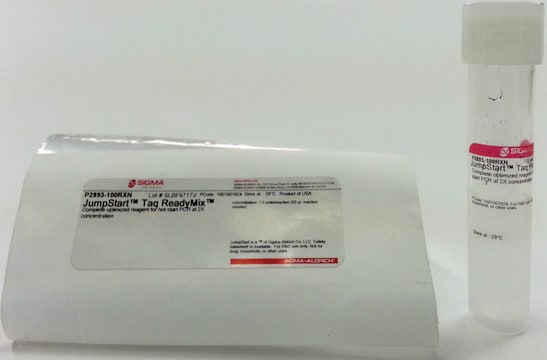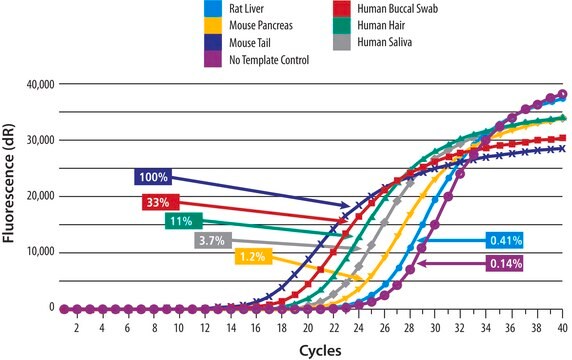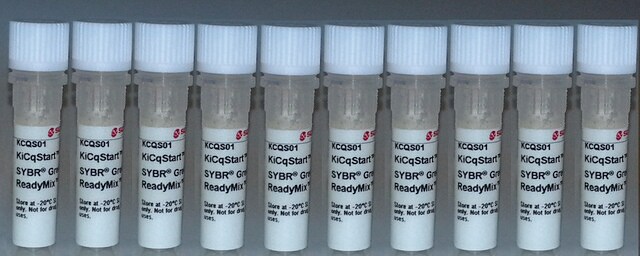Key Documents
S1816
SYBR® Green JumpStart™ Taq ReadyMix™ for Quantitative PCR, Capillary Formulation
SYBR® Green qPCR reagent for Roche LightCycler® capillary systems
About This Item
Polecane produkty
Postać
liquid
zastosowanie
sufficient for 100 reactions
sufficient for 400 reactions
Właściwości
dNTPs included
hotstart
stężenie
1 units/reaction (20 μL reaction volume)
metody
qPCR: suitable
kolor
colorless
moc wejściowa
purified DNA
kompatybilność
for use with Roche LightCycler 480
metoda wykrywania
SYBR® Green
Warunki transportu
wet ice
temp. przechowywania
−20°C
Opis ogólny
SYBR Green Taq ReadyMix is recommended for single product real-time amplification experiments and may also be used for evaluation of primer sequences prior to manufacture of fluorescent-labeled probes. Fluorescent labeled probes are not recommended for use with SYBR Green I dye.
Zastosowanie
Cechy i korzyści
- Convenient 2× concentrate ReadyMix specifically designed for use with capillary instruments such as the Roche LightCycler® and is ideal for high throughput applications
- Increased specificity & target yield - JumpStart™ Taq polymerase prevents non-specific product resulting in more accurate CT values and improved quantitation
- This master mix allows consistency from one reaction to the next
- Designed to reduce the preparation time and minimize contamination from multiple pipetting steps
- The double-strand DNA-specific SYBR® Green I fluorescent dye is inexpensive, easy to use, and sensitive and is ideal for quantifying any DNA sequence
Opakowanie
100RXN is packaged as 1 X 1 mL
400RXN is packaged as 1 X 4 mL
Zasada
The JumpStart Taq antibody inactivates the DNA polymerase at room temperature. When the temperature is raised above 70 °C in the first denaturation step of the cycling process, the complex dissociates and the polymerase becomes fully active. JumpStart Taq DNA polymerase prevents non-specific amplification resulting in more accurate CT values.
To prepare a reaction, 10 μL of ReadyMix is added to primers, template and water for a final reaction volume of 20 μL.
Definicja jednostki
Informacje prawne
produkt powiązany
Kod klasy składowania
10 - Combustible liquids
Klasa zagrożenia wodnego (WGK)
WGK 1
Temperatura zapłonu (°F)
Not applicable
Temperatura zapłonu (°C)
Not applicable
Certyfikaty analizy (CoA)
Poszukaj Certyfikaty analizy (CoA), wpisując numer partii/serii produktów. Numery serii i partii można znaleźć na etykiecie produktu po słowach „seria” lub „partia”.
Masz już ten produkt?
Dokumenty związane z niedawno zakupionymi produktami zostały zamieszczone w Bibliotece dokumentów.
Klienci oglądali również te produkty
Produkty
Quantitative PCR (qPCR) provides information about gene expression, gene amplification or loss, and small alterations. qPCR is often used to investigate tumor biology and to discover the genetic and epigenetic causes of cancer
Obejrzyj te filmy, aby dowiedzieć się, jak działa PCR w czasie rzeczywistym lub ilościowy PCR (qPCR) i jakie są zalety zarówno metod opartych na SYBR Green, jak i metod opartych na sondach qPCR.
Reakcja łańcuchowa polimerazy jest jedną z najczęściej stosowanych technik w biologii molekularnej. Proces PCR składa się z trzech głównych etapów: denaturacji, wygrzewania i wydłużania.
The polymerase chain reaction is one of the most widely used techniques in molecular biology. The PCR process consists of three main steps, Denaturation, Annealing & Extension
Protokoły
A protocol that can be used as a basic template for qPCR incorporating SYBR Green I DNA binding dye that is amenable to modification and applicable for use as validation for a set of primers.
Our SYBR Green qPCR Protocol is a method designed to detect accurate quantification of gene expression and RT-PCR reactions
Nasz protokół SYBR Green qPCR to metoda zaprojektowana do dokładnego wykrywania ilościowego ekspresji genów i reakcji RT-PCR
Powiązane treści
RT-qPCR wykrywa określone cele z zastosowaniami w ekspresji genów i wykrywaniu patogenów.
Nasz zespół naukowców ma doświadczenie we wszystkich obszarach badań, w tym w naukach przyrodniczych, materiałoznawstwie, syntezie chemicznej, chromatografii, analityce i wielu innych dziedzinach.
Skontaktuj się z zespołem ds. pomocy technicznej